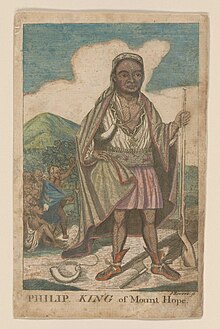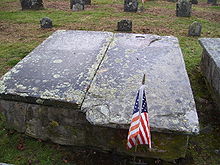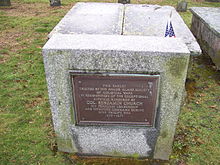Benjamin Church (ranger): Difference between revisions
Hantsheroes (talk | contribs) |
Hantsheroes (talk | contribs) |
||
| Line 54: | Line 54: | ||
In Church's second expedition a year later on 11 September 1690 he arrived with 300 men as Casco Bay. His mission was to relieve the English Fort Pejpescot (present day [[Brunswick, Maine]]), which had been taken by natives.<ref>The history of the great Indian war of 1675 and 1676, commonly called Philip ... By Benjamin Church, Thomas Church, Samuel Gardner Drake, pp179-180</ref> He went up [[Androscoggin River]] to Fort Pejepscot. <ref>Drake, p. (66)</ref> From there he went 40 miles up river to [[Livermore Falls, Maine]] and attacked a native village. 3-4 native men shot in retreat; Church discovered 5 english captives in the wigwams; six or seven prisoners butchered as an example<ref>Drake, p. (67); </ref>; nine prisoners taken. A few days later, in retaliation, the natives attacked Church at [[Cape Elizabeth, Maine|Cape Elizabeth]] on Purpooduc Point, killing 7 of his men and wounding 24 others.<ref>Drake, p. .(p.69).</ref> On September 26, Church returned to Portsmouth, New Hampshire. |
In Church's second expedition a year later on 11 September 1690 he arrived with 300 men as Casco Bay. His mission was to relieve the English Fort Pejpescot (present day [[Brunswick, Maine]]), which had been taken by natives.<ref>The history of the great Indian war of 1675 and 1676, commonly called Philip ... By Benjamin Church, Thomas Church, Samuel Gardner Drake, pp179-180</ref> He went up [[Androscoggin River]] to Fort Pejepscot. <ref>Drake, p. (66)</ref> From there he went 40 miles up river to [[Livermore Falls, Maine]] and attacked a native village. 3-4 native men shot in retreat; Church discovered 5 english captives in the wigwams; six or seven prisoners butchered as an example<ref>Drake, p. (67); </ref>; nine prisoners taken. A few days later, in retaliation, the natives attacked Church at [[Cape Elizabeth, Maine|Cape Elizabeth]] on Purpooduc Point, killing 7 of his men and wounding 24 others.<ref>Drake, p. .(p.69).</ref> On September 26, Church returned to Portsmouth, New Hampshire. |
||
In Church's third expedition during the war, he carried out the Siege of Fort Nashwaak (1696) (present day [[Fredericton, New Brunswick]]) which was then Capital of Acadia, and the [[Raid on Chignecto (1696)]] in [[Acadia]], now holding the rank of major. Despite weighing approximately 250 pounds, he led his troops personally in killing inhabitants of Chignecto, looting their household goods, burning their houses and slaughtering the livestock. |
In Church's third expedition during the war in 1692 and then the forth expedition, he carried out the Siege of Fort Nashwaak (1696) (present day [[Fredericton, New Brunswick]]) which was then Capital of Acadia, and the [[Raid on Chignecto (1696)]] in [[Acadia]], now holding the rank of major..<ref>The history of the great Indian war of 1675 and 1676, commonly called Philip ... By Benjamin Church, Thomas Church, Samuel Gardner Drake, pp215</ref> Despite weighing approximately 250 pounds, he led his troops personally in killing inhabitants of Chignecto, looting their household goods, burning their houses and slaughtering the livestock. |
||
==Queen Anne's War== |
==Queen Anne's War== |
||
Revision as of 09:22, 18 March 2011
Colonel Benjamin Church | |
|---|---|
| File:BenjaminChurchNewYorkPublicLibraryStephenSchwarzmanBuildingPrintCollectionMiriamAndIraWallachDivisionPrintsandPhotographsID1217364.jpg Colonel Benjamin Church: Father of American ranging | |
| Allegiance | Plymouth Colony |
| Service/ | Plymouth Colony Militia |
| Rank | Colonel |
| Battles/wars | King Philip's War
|
| Other work | representative |
Colonel Benjamin Church (c. 1639-January 17, 1718) is considered the father of American ranging.[1] He was the captain of the first Ranger force in America (1676).[2] Church was commissioned by the Governor of the Plymouth Colony Josiah Winslow to form the first ranger company for King Philip's War. He later employed the company to raid Acadia during King Williams War and Queen Anne's War.
Church designed his force primarily to emulate Indian patterns of war. Toward this end, he endeavored to learn to fight like Indians from Indians.[3] Americans became rangers exclusively under the tutelage of the Indian allies. (Until the end of the colonial period, rangers depended on Indians as both allies and teachers.)[4]
Church developed a special full-time unit mixing white colonists selected for frontier skills with friendly Indians to carry out offensive strikes against hostile Indians and French in terrain where normal militia units were ineffective. His memoirs "Entertaining Passages relating to Philip's War" were published in 1716 and are considered the first American military manual.
Family
Born in Plymouth Colony in about 1639, Church married Alice Southworth on December 26, 1667 in Duxbury, Massachusetts. He resided for a time in Duxbury and later moved to Bristol.
King Philip's War

Church was the principal aide to Governor Josiah Winslow of Plymouth Colony. Holding the rank of captain, he fought during King Philip's War (1675–1678) on the New England frontier against the Wampanoag, Nipmuck and Podunk tribes of Indians. He is best known for his actions during this time in commanding a company of men independent of the governor's direct command. Church's men were the first colonial force successful in raiding the Indians' camps in forests and swamps. During previous decades, colonists were on the defense against the Natives, although relations were generally peaceful until 1675.
Church was eventually allowed to recruit Indians when traditional Army tactics of the times were unsuccessful. He persuaded many neutral or formerly hostile Indians to surrender and join his unit, where they operated skillfully as irregular troops. Some of these men had converted to Christianity in settlements before the war. These were known as Praying Indians. After being organized by Church, these troops tracked Indians into the forests and swamps and conducted effective raids and ambushes on their camps.
Great Swamp Fight
During the Great Swamp Fight, Church was wounded while playing a leading role in the battle in which an estimated 300 Narragansetts were killed.[5] The war soon ended after an operation by Church's company on August 12, 1676, when one of Church's Indian allies (John Alderman) killed the chieftain King Philip (also known as Metacomet). Upon inspection of Philip's body, Church is quoted as saying "a doleful, great, naked, dirty beast." Philip was then butchered in a manner standard with English punishment for treason, drawing and quartering.
After the Great Swamp Fight, Benjamin Church and the others hoped to follow the Narragansetts to their villages. The natives had fled leaving Church and others stranded in enemy territory and without provisons. Their expedition began to fight to survival and eventually were forced to eat their horses rather than starve.[6]
King William's War

Over the next 28 years, Church led five New England raiding parties into Acadia (which included most of Maine) against the Acadians and Native Americans. During King William's War, on September 21, 1689, Major Benjamin Church and 250 troops defended the town of Falmouth, Maine from native attack. 21 of his men were killed or wounded.[7] Church then return to Boston leaving the small group of English settlers unprotected. (The following spring, May 1690, Castine returned with over 400 French and native troops and massacred the British settlers. When Church returned to the village he buried the dead.)[8]
In Church's second expedition a year later on 11 September 1690 he arrived with 300 men as Casco Bay. His mission was to relieve the English Fort Pejpescot (present day Brunswick, Maine), which had been taken by natives.[9] He went up Androscoggin River to Fort Pejepscot. [10] From there he went 40 miles up river to Livermore Falls, Maine and attacked a native village. 3-4 native men shot in retreat; Church discovered 5 english captives in the wigwams; six or seven prisoners butchered as an example[11]; nine prisoners taken. A few days later, in retaliation, the natives attacked Church at Cape Elizabeth on Purpooduc Point, killing 7 of his men and wounding 24 others.[12] On September 26, Church returned to Portsmouth, New Hampshire.
In Church's third expedition during the war in 1692 and then the forth expedition, he carried out the Siege of Fort Nashwaak (1696) (present day Fredericton, New Brunswick) which was then Capital of Acadia, and the Raid on Chignecto (1696) in Acadia, now holding the rank of major..[13] Despite weighing approximately 250 pounds, he led his troops personally in killing inhabitants of Chignecto, looting their household goods, burning their houses and slaughtering the livestock.
Queen Anne's War
During Queen Anne's War, in retaliation for the Deerfield Massacre, in 1704 Major Church raided Acadia in the Raid on Castine, Maine, Raid on St. Stephen, New Brunswick, Raid on Grand Pre, Raid on Pisiguit (present day Falmouth and Windsor) and the Raid on Chignecto. Church took prisoners and claimed to have left only five houses standing in Acadia. One of the prominent Acadian prisoners he took in the Raid of Pisiguit (1704) was Noel Doiron.[14]
Legacy


He held public office as the first representative of Bristol at Plymouth between 1682 and 1684. Church died at Little Compton, Rhode Island in 1718 and was buried in the Little Compton Common cemetery.
Church kept notes on his tactics and operations in 1675-1676 which were eventually published in 1716 as "Entertaining Passages relating to Philip's War". Colonel Church was the great-grandfather[15] of Dr. Benjamin Church, the first "Surgeon General" (though that title came later) of the Continental Army. Dr. Benjamin Church, thought to be one of the staunchest Whigs/Patriots, was arrested by George Washington as a spy for General Thomas Gage.
Famous Rangers such as Rogers Rangers and Gorham's Rangers would eventually follow in the tradition begun by Church.
References
Secondary Sources
- Drake, Samuel. The Border Wars of New England. 1910.
- Philip Gould. (1996). Reinventing Benjamin Church: Virtue, Citizenship and the History of King Philip's War in Early National America. Journal of the Early Republic, Vol. 16, No. 4 (Winter, 1996), pp. 645–657
- Grenier, John. The First Way of War: American War Making on the Frontier. Cambridge University Press. 2005
- Philbrick, Nathaniel, Mayflower: A Story of Courage, Community, and War. New York: Viking Penguin, 2006. ISBN 0-670-03760-5
- Faragher, John Mack, A Great and Noble Scheme New York; W. W. Norton & Company, 2005. ISBN 0-393-05135-8
Primary Sources
- The history of King Philip's war ; also of expeditions against the French and Indians in its Eastern parts of New England, in the years 1689, 1692, i696 AND 1704. With some account of the divine providence towards Col. Benjamin Church. By Benjamin Church, Thomas Church, Samuel Gardner Drake(See Benjamin Church - Online Book)
- The History of the Great Indian War Church's Book
Endnotes
- ^ John Grenier. The First Way of War: American War Making on the Frontier. Cambridge University Press. 2005. p. 35
- ^ John Grenier. The First Way of War: American War Making on the Frontier. Cambridge University Press. 2005. p. 33
- ^ John Grenier. The First Way of War: American War Making on the Frontier. Cambridge University Press. 2005. p. 35
- ^ John Grenier, p. 33-34
- ^ John Grenier. The First Way of War. Cambridge University Press. 2005. p. 32
- ^ Grenier, p. 32
- ^ Drake, The Border Wars of New England, p. 33
- ^ The history of the great Indian war of 1675 and 1676, commonly called Philip ... By Benjamin Church, Thomas Church, Samuel Gardner Drake, pp175-176
- ^ The history of the great Indian war of 1675 and 1676, commonly called Philip ... By Benjamin Church, Thomas Church, Samuel Gardner Drake, pp179-180
- ^ Drake, p. (66)
- ^ Drake, p. (67);
- ^ Drake, p. .(p.69).
- ^ The history of the great Indian war of 1675 and 1676, commonly called Philip ... By Benjamin Church, Thomas Church, Samuel Gardner Drake, pp215
- ^ Scott, S. and Scott, T. Noel Doiron and the East Hants Acadians. The Journal: The Nova Scotia HIstorical Society.
- ^ Wakefield, Robert S. Richard Church and His Descendants for Four Generations: General Society of Mayflower Descendants, 1998
Links
- US Army Ranger Hall of Fame
- Historical Biographies, Nova Scotia
- Lepore, Jill, "Plymouth Rocked", The New Yorker, April 24, 2006 Lepore doubts the veracity of Church's memoirs.
